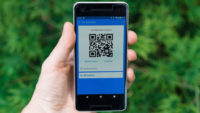During the COVID-19 pandemic, QR codes that allow customers to order and pay for food and drinks caught on in restaurants and appear to be here for good. Retail chains including CVS and Foot Locker have also added them as have marketers. Because QR codes can store digital information and open an app or website that tracks peoples’ personal information, they’re ideal for vendors looking to create their own customer databases. Consumers will soon be served customized offers marketed within QR code payment systems.
The New York Times reports the National Restaurant Association stated that “half of all full-service restaurant operators in the United States have added QR code menus since the start of the pandemic.” Cheqout co-founder Tom Sharon reported that, “restaurants that use QR code menus can save 30 percent to 50 percent on labor costs by reducing or eliminating the need for servers to take orders and collect payments.”

However, American Civil Liberties Union senior policy analyst Jay Stanley noted privacy issues. “People don’t understand that when you use a QR code, it inserts the entire apparatus of online tracking between you and your meal,” he said. “Suddenly your offline activity of sitting down for a meal has become part of the online advertising empire.”
The codes were invented in 1994, originally to streamline car manufacturing at a Japanese company, and are now “widely used in China in recent years after being integrated into the Alipay and WeChat Pay digital payment apps.”
In the U.S., QR codes were slower to take off, due to “clumsy marketing, a lack of consumer understanding and the hassle of needing a special app to scan the codes,” according to Scott Stratten who wrote “QR Codes Kill Kittens” with his wife Alison Kramer. But when Apple enabled iPhone cameras to recognize QR codes in 2017, the technology began to catch on. The COVID-19 pandemic fueled its widespread adoption at PayPal, CVS, Nike, Foot Locker and “around one million small businesses.”
At Stanford University’s Digital Civil Society Lab, director Lucy Bernholz said that QR codes “are an important first step toward making your experience in physical space outside of your home feel just like being tracked by Google on your screen.”
ZDNet reports that, “Apple’s alleged innovation-stifling practices where its NFC tech is concerned have now become the focus of an Australian Parliamentary committee, which on Monday heard the case for government intervention.” More specifically, “the only payment application that can access the near-field communication (NFC) interface on an iPhone is Apple Pay.”
Apple cites security as one of the reasons it hasn’t added Host Code Emulation (HCE) adopted by Android, as well as its “tight integration between the operating system and its own hardware.”
“One has to remember that Australia was one of the first adopters of NFC contactless card payments, which became ubiquitous here, way before they became ubiquitous in any other country,” said The Initiatives Group managing director Lance Blockley. “And so NFC terminals at point of sale were much more ubiquitous here than they were in any other country and hence, the NFC interface became more valuable here.”
Related:
QR Menu Codes Are Everywhere – and Tracking You More Than You Think, Gizmodo, 7/26/21
That Online Menu You Read by Scanning a QR Code Might Still Be Tracking You, and Privacy Experts Are Worried, Business Insider, 7/26/21

No Comments Yet
You can be the first to comment!
Sorry, comments for this entry are closed at this time.